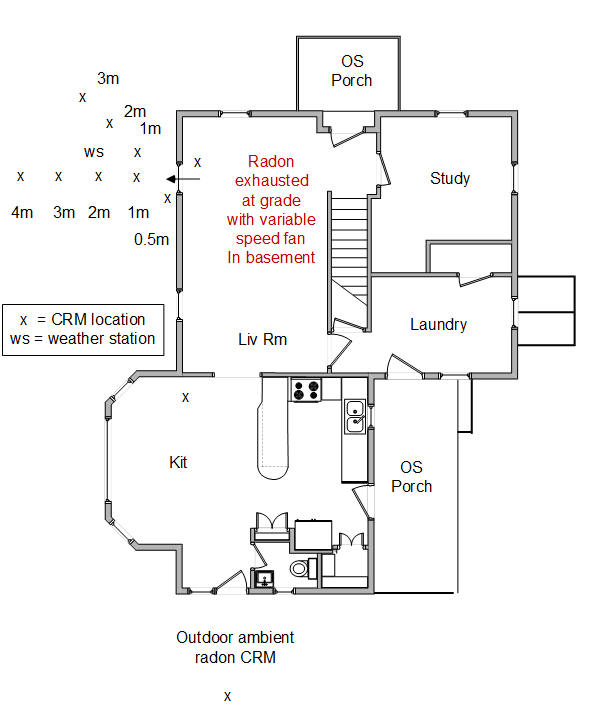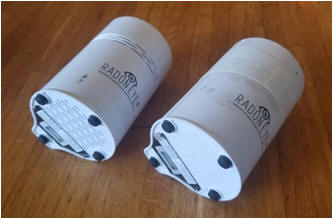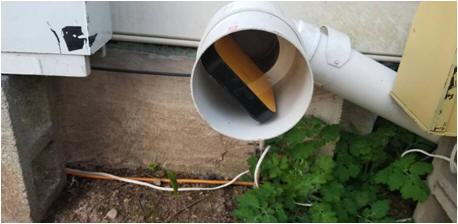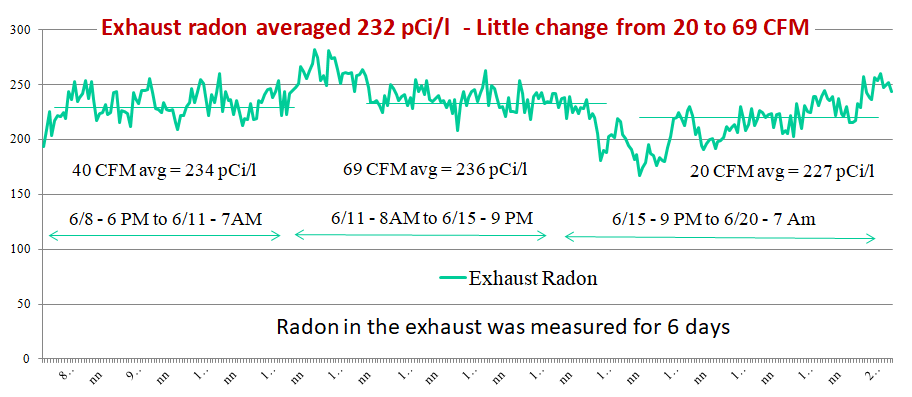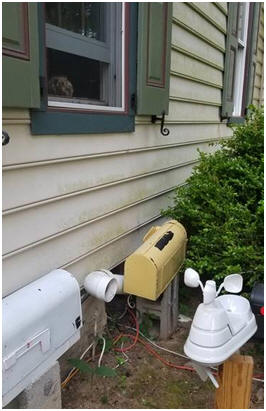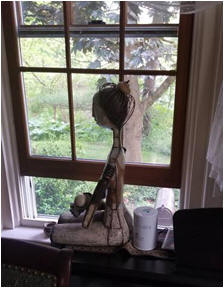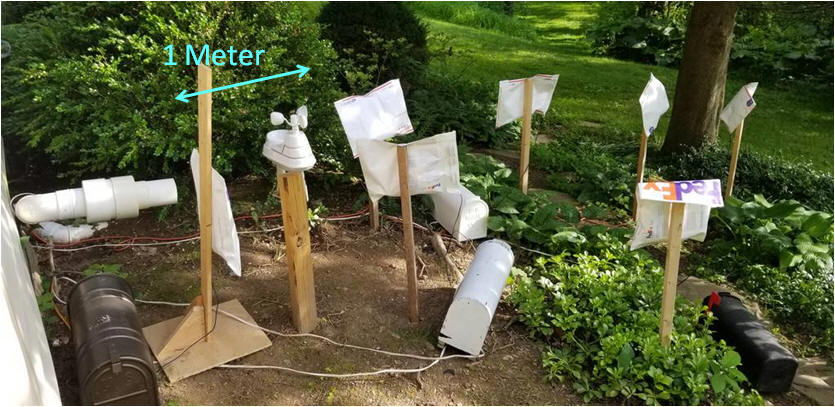 |
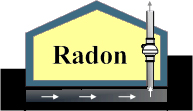 |
Bill Brodhead WPB Enterprises Inc
Radon & Vapor Intrusion |
 |
 |
|
Bill Brodhead WPB Enterprises Inc.
Radon & Vapor Intrusion |
 |
 |
|
 |
 |
Do we need to vent Radon ASD systems
|
 |
|
The following Table has the average results in pCi/l for each of the CRM locations in each test. |
|
|
| Re-entrainment Test |
5/10/20 5/17/20 |
4/25/20 5/5/20 |
5/17/20 5/21/20 |
4/21/20 4/25/20 |
5/21/20 5/26/20 |
5/5/20 5/10/20 |
| # Test Days | 6.96 | 9.46 | 4.42 | 4.125 | 4.92 | 4.96 |
|
Exhaust Outlet |
20 CFM 3" |
20 CFM 4" |
40 CFM 3" |
40 CFM 4" |
40 CFM 4" |
69 CFM 4" |
| Backyard Rn | 0.56 | 0.37 | 0.46 | 0.43 | 0.65 | 0.34 |
| 18" on Left | 0.84 | 0.84 | 1.45 | 0.88 | 0.80 | 1.00 |
| 18" on Right | 0.69 | 0.68 | 1.40 | 0.76 | 0.91 | 0.76 |
| 2 ft out | 14.2 | 6.7 | 38.9 | 25.1 | 7.7 | 32.8 |
| Bas Center | 2.6 | 2.5 | 1.7 | 1.7 | 1.8 | 1.5 |
| Bas Window | 2.4 | 2.4 | 1.9 | 1.5 | 2.1 | 1.5 |
| 1st Flr window | 1.2 | 1.2 | 0.8 | 0.8 | 1.3 | 0.7 |
| 1st Flr kitchen | 1.2 | 1.3 | 0.7 | 0.8 | 0.9 | 0.7 |
| 2nd Flr | 1.3 | 1.3 | 0.7 | 1.0 | 0.9 | 0.8 |
| 3rd Flr | 1.3 | 1.3 | 0.7 | 0.9 | n/a | 0.8 |
| Notes | 1st Flr window open |
|
Average radon results in pCi/l - CRM's around exhaust |
|
|
|
Prior to measuring the outdoor radon dispersion, six radon tests each lasting four to nine days in length were run in order to determine if radon was re-entraining into the house. Six CRM's were placed in the house. One CRM was placed directly next to the window above the exhaust while a reference CRM was placed 20 feet away in the kitchen. Another CRM was placed next to the basement window where the radon system piping exited the basement while a reference CRM was placed in the center of the basement. These CRM's on the same level of the home were used to determine if there was any elevated radon re-entering the house from the at grade exhaust. There were also CRMs on the second and third floor of the home. The picture below shows the radon system exhaust outlet during these six initial test runs. There were three outdoor CRM's placed in plastic mailboxes with holes drilled in the bottom of the mail box. A CRM was placed 18 inches (0.5 meters) on either side of the exhaust and about two feet out in direct alignment with the exhaust. There was also a fourth CRM placed on a picnic table in the back yard 40 feet from the exhaust to measure outdoor ambient radon levels. A weather station was set up at grade and on the roof.
The main conclusion from these initial six tests is that the radon levels measured inside the home at the basement window and at the 1st floor window that were directly next to the outside system exhaust were almost identical to radon tests done on the same floor away from these locations. No significant difference was noted on these tests indicating very little radon was re-entering the house from the system exhaust. During one of the tests when the system was exhausting 40 CFM, the window directly above the exhaust was left open for five days. The average radon at the open window was 0.4 pCi/l greater than the kitchen and the basement window directly below this window was reading 0.3 pCi/l greater than the center of the basement. A picture of the open window is included below. Even with an open window near the exhaust the indoor radon levels appear to only be increasing by 0.4 pCi/l or about 0.17% of the exhaust radon levels.
The next round of testing was to determine the diffusion of radon from an ASD system exhausting at grade. Four CRMs were placed in direct alignment of the exhaust at 1,2,3 and 4 meters from the exhaust outlet. Three CRMs were placed at a 45 degree angle from the exhaust outlet at 1,2 and 3 meters away. See the house drawing above. The CRM's were placed in tyvek envelopes to protect them from weather. See picture below. The tyvek has been previously determined to be transparent to radon. The following are the average results of each of the CRMs during each of the test runs in which the airflow or the outlet size was varied: |
|
|
| Outside Diffusion |
6/20/20 6/27/20 |
6/15/20 6/20/20 |
6/27/20 7/5/20 |
6/8/20 6/11/20 |
7/8/20 7/16/20 |
6/11/20 6/15/20 |
| # Test Days | 2.7 | 4.5 | 4.2 | 6.6 | 8.0 | 4.2 |
|
Exhaust Outlet |
20 CFM 3" |
20 CFM 4" |
40 CFM 3" |
40 CFM 4" |
63 CFM 3" |
69 CFM 4" |
| Backyard Rn | 0.73 | 0.61 | 0.68 | 0.68 | 0.53 | 0.40 |
| 1 meter out | 15.3 | 16.76 | 25.34 | 32.48 | 30.69 | 44.14 |
| 2 meters out | 1.85 | 1.50 | 7.61 | 9.54 | 10.44 | 9.55 |
| 3 meters out | 0.78 | 0.56 | 3.75 | 3.08 | 4.89 | 3.72 |
| 4 meters out | 0.15 | 0.17 | 0.85 | 1.06 | 2.15 | 0.65 |
| 1 meter 45* | 3.59 | 3.11 | 4.32 | 6.17 | 1.88 | 3.91 |
| 2 meters 45* | 1.46 | 1.21 | 3.87 | 3.37 | 3.28 | |
| 3 meters 45* | 0.18 | 0.19 | 1.44 | 1.25 | 1.19 | 1.34 |
| 0.5 meter side | 0.62 | 0.69 | 0.35 | 0.53 | 0.02 | 0.5 |
| Bas center | 1.30 | 2.25 | 2.07 | 1.75 | 1.42 | 1.30 |
| 2nd floor | 0.54 | 0.84 | 1.02 | 0.87 | 0.55 | 0.54 |
|
The average CRM result for each test run is displayed above with the ambient background subtracted from the actual results. Note that one meter out the radon levels were higher as the exhaust flow increased. For 2, 3 and 4 meters out the 20 CFM airflow was definitely lower than than 40 and 69 CFM airflow, while the increase from 40 to 69 CFM was less pronounced and varied. The 45 degree results at 1 meter were similar to the results at 3 meters directly in line with the exhaust. Most important measurement from this study is the results at 0.5 meters to the side of the exhaust. This is the location that would be the area of concern for radon re-entrainment back into the house. The lower line of the table above has the side exhaust CRM results with the highest radon results at lower airflow. The average radon results beside the exhaust were less than the results at 4 meters in direct line with the exhaust for airflows of 40 CFM and greater. |
|
|
| # Test Days | 7.2 | 10.8 | 12.2 |
|
Exhaust Outlet |
20 CFM 3" & 4" |
40 CFM 3" & 4" |
63 to 69 CFM 3" & 4" |
| 1 meter out | 7.1% | 12.4% | 15.8% |
| 2 meters out | 0.7% | 3.7% | 4.2% |
| 3 meters out | 0.3% | 1.5% | 1.8% |
| 4 meters out | 0.1% | 0.4% | 0.6% |
| 1 meter 45* | 1.5% | 2.2% | 1.2% |
| 2 meters 45* | 0.6% | 1.5% | 1.4% |
| 3 meters 45* | 0.1% | 0.6% | 0.5% |
| 0.5 meter side | 0.3% | 0.2% | 0.1% |
|
|
|
To give an example of how percentages at each location would translate into actual radon averages depending on the exhaust concentration the following table lists the results for two different radon ASD system exhaust levels of 270 and 1081 pCi/l. As an example using the 1081 pCi/l exhaust and 15% and the 1.0 meter percentage at 69 CFM of 15.8% would produce an average of 250 pCi/l at the 1.0 meter distance in direct alignment with the exhaust. The more typical radon system exhaust of 270 pCi/l even at a low flow rate of 20 CFM would only produce an average of about 1.0 pCi/l around the exhaust. Since this is also a small percentage of the perimeter of the home and the leakage into the home at this location is likely to be low it would appear that signficant re-entrainment would be very unlikely even at more rare case of radon exhaust higher than 1081 pCi/l. |
|
|
| % of Exhaust Radon |
270 pCi/l 10,000 Bq/m3 |
1081 pCi/l 40,000 Bq/m3 |
| 0.1% | 0.3 pCi/l | 1.1 pCi/l |
| 1% | 2.7 pCi/l | 10.8 pCi/l |
| 5% | 13.5 pCi/l | 54.1 pCi/l |
| 10% | 27.0 pCi/l | 108.1 pCi/l |
| 15% | 40.5 pCi/l | 162.1 pCi/l |
|
The conclusions of the study is that it would be very unlikely to have significant re-entrainment of radon from an At-Grade ASD exhaust if it was aimed directly away from the home. There is however significant radon exposure in the first few meters in the direction of the exhaust with a diminishing amount at a 45 degree angle. Consideration needs to be given to ensuring that this area is not routinely occupied especially if the area has restricted air movement. Higher exhaust velocity did not consistently reduce side exhaust concentrations. Consideration of the exhaust velocity should be considered when the exhaust radon levels are known to be very high (>1,000 pCi/l or 40,000 Bq/m3) |
 |
|
Download Radon Re-Entrainment and Diffusion paper as a pdf Lots of Other info
|
 |
 |
Do We Need to Vent
|
|
Health Canada did research on at grade versus at roof ASD exhaust outlet in 2012 and concluded that there was no signficant radon re-entrainment back into the house from ground exhaust that is aimed directly away from the building. The EPA decision to require above roof exhaust as part of their 1991 radon mitigation standards was primarily based on a 38 home study in Pennsylvania that had a high percentage of at grade exhaust ASD systems causing elevated radon indoors. The initial system installations done in 1988 and 1989 had most of the at grade system exhaust directed against the siding of the home rather than directed away. Later system revisions that directed the exhaust to the roof or directly out from the home eliminated or minimized the re-entrainment. Further wind tunnel tests after 1991 RMS was published confirmed that at grade exhaust would not contribute significant re-entrainment. Since those early studies, no US research of ground based exhaust has been published. This study was done to determine if ground based exhaust would cause significant radon re-entrainment and how does radon diffuse when it is exhausted to the outside at grade. The full paper is available At-Grade Radon System Exhaust Diffusion In order to study system exhaust diffusion, a single home was studied with the radon system modified to exhaust at grade with a variable speed fan mounted in the basement. Exhaust was varied from 20 to 40 to 69 CFM. The exhaust outlet was varied from 3" (75mm) to 4" (100mm). Eight continuous radon monitors (CRM's) were placed at varying distances from the system exhaust. An additional CRM was placed in the backyard to measure ambient outdoor radon levels. A CRM was also placed in the exhaust pipe to measure the exhaust radon concentration. Weather data was collected near the exhaust and also at the roof line. Each of the initial six sequences were run from 4 to 8 days so that periods of no wind movement could be recorded. The following is the layout of the final six exhaust diffusion tests. The "x" marks the locations of the CRMs. The distances from the exhaust outlet are in meters represented by "m". The "WS" is the location of the weather station.
The ASD system exhaust turned out to have about 221 pCi/l of radon and 226 pCi/l of thoron. In order to minimize the effect of thoron the CRM's had 6 mil plastic tape placed over the slotted openings of the radon monitors. This reduced the CRM thoron sensitivity to a few percent. See CRM calibration adjustment results in the full paper.
In order to accurate measure the radon in the exhaust a Corentium Pro radon monitor was placed in the air stream of the exhaust by using two 4x6 adaptors and placing the monitor inside the pipe.
During three of the diffusion runs the exhaust radon levels were measured with the Corentium Pro. Even though the exhaust flow was changed from 20 to 40 to 69 CFM the actual radon levels in the exhaust did not vary significantly. This was likely due to the lack of basement or outdoor air being drawn into the system as the suction pressure and airflow increased. This consistence was helpful for the study because as airflow increases with the same radon concentration the actual quantity of radon atoms being dispersed is increased proportionally.
Prior to measuring the outdoor radon dispersion, six radon tests each lasting four to nine days in length were run in order to determine if radon was re-entraining into the house. Six CRM's were placed in the house. One CRM was placed directly next to the window above the exhaust while a reference CRM was placed 20 feet away in the kitchen. Another CRM was placed next to the basement window where the radon system piping exited the basement while a reference CRM was placed in the center of the basement. These CRM's on the same level of the home were used to determine if there was any elevated radon re-entering the house from the at grade exhaust. There were also CRMs on the second and third floor of the home. This is a picture of the radon system exhaust outlet during these six initial test runs. There were three outdoor CRM's placed in plastic mailboxes with holes drilled in the bottom of the mail box. A CRM was placed 18 inches (0.5 meters) on either side of the exhaust and about two feet out in direct alignment with the exhaust. There was also a fourth CRM placed on a picnic table in the back yard 40 feet from the exhaust to measure outdoor ambient radon levels. A weather station was set up at grade and on the roof.
|
 |
|
The following Table has the average results in pCi/l for each of the CRM locations in each test. |
|
|
| Re-entrainment Test |
5/10/20 5/17/20 |
4/25/20 5/5/20 |
5/17/20 5/21/20 |
4/21/20 4/25/20 |
5/21/20 5/26/20 |
5/5/20 5/10/20 |
| # Test Days | 6.96 | 9.46 | 4.42 | 4.125 | 4.92 | 4.96 |
|
Exhaust Outlet |
20 CFM 3" |
20 CFM 4" |
40 CFM 3" |
40 CFM 4" |
40 CFM 4" |
69 CFM 4" |
| Backyard Rn | 0.56 | 0.37 | 0.46 | 0.43 | 0.65 | 0.34 |
| 18" on Left | 0.84 | 0.84 | 1.45 | 0.88 | 0.80 | 1.00 |
| 18" on Right | 0.69 | 0.68 | 1.40 | 0.76 | 0.91 | 0.76 |
| 2 ft out | 14.2 | 6.7 | 38.9 | 25.1 | 7.7 | 32.8 |
| Bas Center | 2.6 | 2.5 | 1.7 | 1.7 | 1.8 | 1.5 |
| Bas Window | 2.4 | 2.4 | 1.9 | 1.5 | 2.1 | 1.5 |
| 1st Flr window | 1.2 | 1.2 | 0.8 | 0.8 | 1.3 | 0.7 |
| 1st Flr kitchen | 1.2 | 1.3 | 0.7 | 0.8 | 0.9 | 0.7 |
| 2nd Flr | 1.3 | 1.3 | 0.7 | 1.0 | 0.9 | 0.8 |
| 3rd Flr | 1.3 | 1.3 | 0.7 | 0.9 | n/a | 0.8 |
| Notes | 1st Flr window open |
|
Average radon results in pCi/l - CRM's around exhaust |
|
|
|
Prior to measuring the outdoor radon dispersion, six radon tests each lasting four to nine days in length were run in order to determine if radon was re-entraining into the house. Six CRM's were placed in the house. One CRM was placed directly next to the window above the exhaust while a reference CRM was placed 20 feet away in the kitchen. Another CRM was placed next to the basement window where the radon system piping exited the basement while a reference CRM was placed in the center of the basement. These CRM's on the same level of the home were used to determine if there was any elevated radon re-entering the house from the at grade exhaust. There were also CRMs on the second and third floor of the home. The picture below shows the radon system exhaust outlet during these six initial test runs. There were three outdoor CRM's placed in plastic mailboxes with holes drilled in the bottom of the mail box. A CRM was placed 18 inches (0.5 meters) on either side of the exhaust and about two feet out in direct alignment with the exhaust. There was also a fourth CRM placed on a picnic table in the back yard 40 feet from the exhaust to measure outdoor ambient radon levels. A weather station was set up at grade and on the roof.
The main conclusion from these initial six tests is that the radon levels measured inside the home at the basement window and at the 1st floor window that were directly next to the outside system exhaust were almost identical to radon tests done on the same floor away from these locations. No significant difference was noted on these tests indicating very little radon was re-entering the house from the system exhaust. During one of the tests when the system was exhausting 40 CFM, the window directly above the exhaust was left open for five days. The average radon at the open window was 0.4 pCi/l greater than the kitchen and the basement window directly below this window was reading 0.3 pCi/l greater than the center of the basement. A picture of the open window is included below. Even with an open window near the exhaust the indoor radon levels appear to only be increasing by 0.4 pCi/l or about 0.17% of the exhaust radon levels.
The next round of testing was to determine the diffusion of radon from an ASD system exhausting at grade. Four CRMs were placed in direct alignment of the exhaust at 1,2,3 and 4 meters from the exhaust outlet. Three CRMs were placed at a 45 degree angle from the exhaust outlet at 1,2 and 3 meters away. See the house drawing above. The CRM's were placed in tyvek envelopes to protect them from weather. See picture below. The tyvek has been previously determined to be transparent to radon. The following are the average results of each of the CRMs during each of the test runs in which the airflow or the outlet size was varied: |
|
|
| Outside Diffusion |
6/20/20 6/27/20 |
6/15/20 6/20/20 |
6/27/20 7/5/20 |
6/8/20 6/11/20 |
7/8/20 7/16/20 |
6/11/20 6/15/20 |
| # Test Days | 2.7 | 4.5 | 4.2 | 6.6 | 8.0 | 4.2 |
|
Exhaust Outlet |
20 CFM 3" |
20 CFM 4" |
40 CFM 3" |
40 CFM 4" |
63 CFM 3" |
69 CFM 4" |
| Backyard Rn | 0.73 | 0.61 | 0.68 | 0.68 | 0.53 | 0.40 |
| 1 meter out | 15.3 | 16.76 | 25.34 | 32.48 | 30.69 | 44.14 |
| 2 meters out | 1.85 | 1.50 | 7.61 | 9.54 | 10.44 | 9.55 |
| 3 meters out | 0.78 | 0.56 | 3.75 | 3.08 | 4.89 | 3.72 |
| 4 meters out | 0.15 | 0.17 | 0.85 | 1.06 | 2.15 | 0.65 |
| 1 meter 45* | 3.59 | 3.11 | 4.32 | 6.17 | 1.88 | 3.91 |
| 2 meters 45* | 1.46 | 1.21 | 3.87 | 3.37 | 3.28 | |
| 3 meters 45* | 0.18 | 0.19 | 1.44 | 1.25 | 1.19 | 1.34 |
| 0.5 meter side | 0.62 | 0.69 | 0.35 | 0.53 | 0.02 | 0.5 |
| Bas center | 1.30 | 2.25 | 2.07 | 1.75 | 1.42 | 1.30 |
| 2nd floor | 0.54 | 0.84 | 1.02 | 0.87 | 0.55 | 0.54 |
|
The average CRM result for each test run is displayed above with the ambient background subtracted from the actual results. Note that one meter out the radon levels were higher as the exhaust flow increased. For 2, 3 and 4 meters out the 20 CFM airflow was definitely lower than than 40 and 69 CFM airflow, while the increase from 40 to 69 CFM was less pronounced and varied. The 45 degree results at 1 meter were similar to the results at 3 meters directly in line with the exhaust. Most important measurement from this study is the results at 0.5 meters to the side of the exhaust. This is the location that would be the area of concern for radon re-entrainment back into the house. The lower line of the table above has the side exhaust CRM results with the highest radon results at lower airflow. The average radon results beside the exhaust were less than the results at 4 meters in direct line with the exhaust for airflows of 40 CFM and greater. |
|
|
| # Test Days | 7.2 | 10.8 | 12.2 |
|
Exhaust Outlet |
20 CFM 3" & 4" |
40 CFM 3" & 4" |
63 to 69 CFM 3" & 4" |
| 1 meter out | 7.1% | 12.4% | 15.8% |
| 2 meters out | 0.7% | 3.7% | 4.2% |
| 3 meters out | 0.3% | 1.5% | 1.8% |
| 4 meters out | 0.1% | 0.4% | 0.6% |
| 1 meter 45* | 1.5% | 2.2% | 1.2% |
| 2 meters 45* | 0.6% | 1.5% | 1.4% |
| 3 meters 45* | 0.1% | 0.6% | 0.5% |
| 0.5 meter side | 0.3% | 0.2% | 0.1% |
|
|
|
To give an example of how percentages at each location would translate into actual radon averages depending on the exhaust concentration the following table lists the results for two different radon ASD system exhaust levels of 270 and 1081 pCi/l. As an example using the 1081 pCi/l exhaust and 15% and the 1.0 meter percentage at 69 CFM of 15.8% would produce an average of 250 pCi/l at the 1.0 meter distance in direct alignment with the exhaust. The more typical radon system exhaust of 270 pCi/l even at a low flow rate of 20 CFM would only produce an average of about 1.0 pCi/l around the exhaust. Since this is also a small percentage of the perimeter of the home and the leakage into the home at this location is likely to be low it would appear that signficant re-entrainment would be very unlikely even at more rare case of radon exhaust higher than 1081 pCi/l. |
|
|
| % of Exhaust Radon |
270 pCi/l 10,000 Bq/m3 |
1081 pCi/l 40,000 Bq/m3 |
| 0.1% | 0.3 pCi/l | 1.1 pCi/l |
| 1% | 2.7 pCi/l | 10.8 pCi/l |
| 5% | 13.5 pCi/l | 54.1 pCi/l |
| 10% | 27.0 pCi/l | 108.1 pCi/l |
| 15% | 40.5 pCi/l | 162.1 pCi/l |
|
The conclusions of the study is that it would be very unlikely to have significant re-entrainment of radon from an At-Grade ASD exhaust if it was aimed directly away from the home. There is however significant radon exposure in the first few meters in the direction of the exhaust with a diminishing amount at a 45 degree angle. Consideration needs to be given to ensuring that this area is not routinely occupied especially if the area has restricted air movement. Higher exhaust velocity did not consistently reduce side exhaust concentrations. Consideration of the exhaust velocity should be considered when the exhaust radon levels are known to be very high (>1,000 pCi/l or 40,000 Bq/m3) |
 |
|
Download Radon Re-Entrainment and Diffusion paper as a pdf Lots of Other info
|
 |
